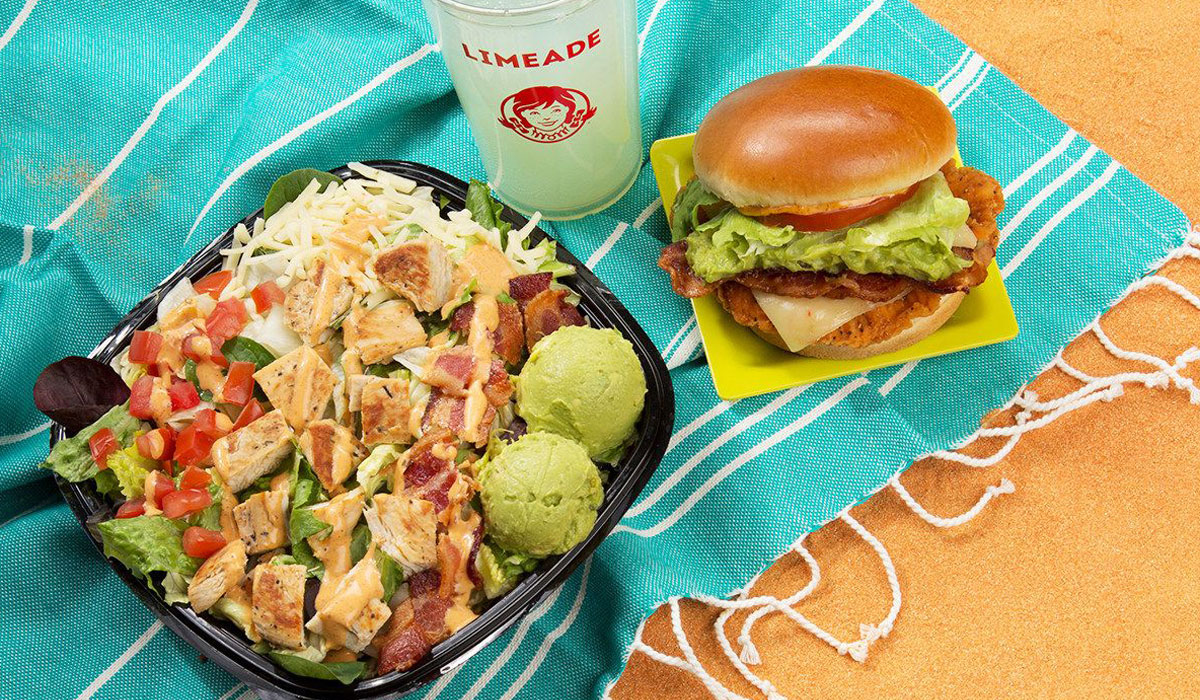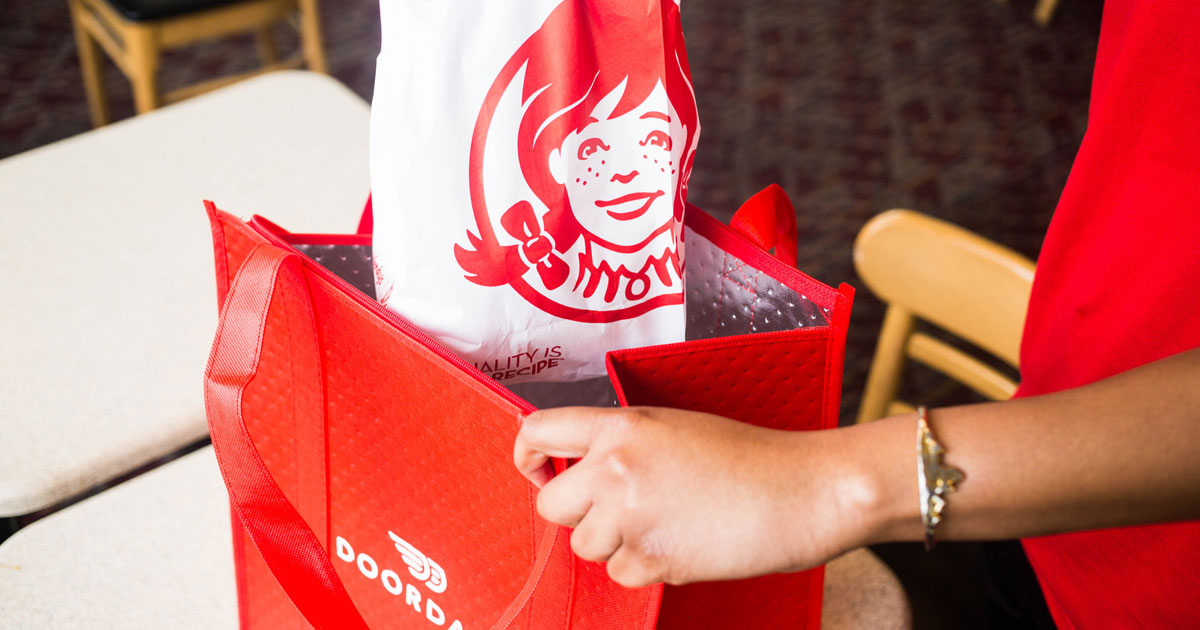Wendy’s delivery rollout is progressing faster than executives hoped. Following its 22nd consecutive quarter of positive same-store sales—a streak unmatched in the burger space—the brand dove into its rapidly evolving off-premises future. The word “delivery” came up 37 times during Wednesday’s conference call to review Wendy’s Q2 results.
As for the results themselves, Wendy’s reported same-store sales gains of 1.9 percent in the second quarter, building off Q2 2016’s 3.2 percent gain. The chain had quarterly revenues of $411 million, a 3.9 percent increase from the year-ago period, and better than Wall Street’s call for $408 million. The lift was credited, in part, to increased rental revenues related to “franchise flips” completed in 2017.
READ MORE: Wendy’s sees McDonald’s fresh beef as an opportunity.
Returning to the delivery topic, president and CEO Todd Penegor said 40 percent of Wendy’s North American restaurants are currently offering the service, up from 25 percent at the end of the first quarter. It was 20 percent at the end of fiscal 2017.
“We have an increased focus on bringing more awareness to delivery throughout the remainder of 2018,” he said. “We have seen an increase in the number of transactions made through delivery when we put advertising weight behind the platform, such as taking national TV ads or offering free delivery with a minimum purchase.”
Wendy’s is putting weight behind the investment because the delivery economics are there, he added. Average check sizes are one-and-half to two times higher than in-store orders, and “we continue to see incrementality and customer repeat,” Penegor said.
Another encouraging point: Wendy’s is seeing its strongest customer satisfaction scores from delivery. This isn’t exactly standard throughout foodservice, and it’s plenty of incentive for Wendy’s to accelerate the platform. Wendy’s works with DoorDash in the U.S. and SkipTheDishes in Canada. U.S. orders are taking just over 30 minutes on average, and Wendy’s is seeing a bit more business in the evening and dinner daypart. Penegor said Wendy’s is working to integrate DoorDash into its app some time in the future.
He added that it’s had really no impact to Wendy’s restaurant margin. “We’ve managed the service fee where the consumer pays, and the way we’ve worked with DoorDash, we’ve worked our menu pricing as appropriate to pass on that restaurant level commission to the consumer,” Penegor said.
A key in all of this has been Wendy’s ability to drive awareness into the platform. In June, Wendy’s unveiled its first national TV spot dedicated to delivery. The campaign was a first for DoorDash as well. Pulsing offers and offering free delivery has helped.
“You can start to see during the course of some of our ad campaigns in the second quarter and on-air today is we’re supporting Dave’s Double, we’re also taking free delivery,” Penegor said. “So our opportunity is to continue to educate folks that DoorDash is our partner, that you go to DoorDash and you can get free delivery during some of these promotional windows to get them really comfortable with the overall service experience that we know we can provide.”
“We’ll have to continue to work with our partner and how their economics and our economics work,” he added later in the call. “But to the extent that they have large partners like us, we can help drive awareness to the DoorDash brand, just as much as DoorDash can provide awareness to our brand by offering free delivery and getting us better placement in the app.”

Would Wendy’s buy another brand?
The Wall Street Journal reported in mid-July that Wendy’s held merger talks with Papa John’s. The preliminary conversation fizzled following the John Schnatter incident, namely a July 11 report that Schnatter, the pizza chain’s founder, used a racial slur during an in-company conference call.
When asked if Wendy’s would consider future M&A opportunities, Penegor responded: “Yeah, we’d have to look at would it complement the capabilities that we have? Could it accelerate the capabilities that we have? Would it work for our franchise community?”
“But that said, investing in growth is our number one priority, and that’s we’ll stay focused,” he said.
Nothing new for now, but definitely worth keeping an eye on.
And about that growth …
Wendy’s opened 36 restaurants globally in Q2, including 25 in North America. Net with closures, Wendy’s expanded its footprint by 23 restaurants (13 in North America), bringing its development to 22 net openings globally year-to-date. There are more than 6,600 units worldwide and Wendy’s is sticking to its 2020 target of 7,250 global restaurants.
Wendy’s also continues to evolve its system with “franchise flips.” Last February, Penegor said, thanks to these franchisee-to-franchisee restaurant transfers, nearly 40 percent of its North American system had changed hands—a process he said strengthens Wendy’s system by ensuring restaurants are in the control of strong operators with access to capital. The chain completed 64 franchise flips in Q2 and is on pace for 200 in 2018.
Wendy’s continues to update its design through an Image Activation program, with plans to expand by about 10 percent this year. That would put Wendy’s north of 50 percent by fiscal 2019.
The company’s is curating smaller footprints to fit Wendy’s into all trade areas as well. There’s now anything from a 28-seat dining room store to 45 to 55 to the traditional 65-plus seaters. Wendy’s opened a “Smart 2.0” restaurant that pulled another $150,000 of costs out of the restaurant by optimizing its footprint. This built on Smart 1.0, which is a big part of Wendy’s pipeline today, Penegor said. The next iteration will play a role next year.

Leadership in the digital age
Wendy’s chief information officer David Trimm is retiring early 2019. With that news, the company took a fresh look at its technology platforms and decided to refocus its leadership structure moving forward “to ensure we continue to leverage technology across all we do,” Penegor said.
Kurt Cane, Wendy’s chief concept and marketing officer, will lead all digital initiatives under a newly created “Digital Experience Organization.”
Additionally, Wendy’s engaged a global consulting firm to accelerate its move toward consumer-facing technology, such as mobile ordering, rewards, and kiosks. About 60 percent of Wendy’s stores feature kiosk technology.
CFO Gunther Plosch is expanding his role by taking on all enterprise technology to ensure Wendy’s has a strong foundation across all of its IT systems.
Next, chief operation officer and head of international Bob Wright is transitioning his international responsibilities to Abigail Pringle. Wright instead will oversee in-restaurant technology and turn focus to driving operational excellence in North American units. Pringle will take on a newly create role of chief global development officer and head of international.
To say Wendy’s is taking its digital future seriously would be it stating it lightly.
The value of value (and fresh beef)
Wendy’s launched a 2 for $6 promotion in Q2. Penegor said it allowed “us to offer consumers some of our most popular menu items at a compelling price point.” It was a hit with loyal guests and was a nice check builder, he added. The Southwest Avocado Chicken Sandwich and salad LTO balanced out the calendar and highlighted Wendy’s commitment to fresh ingredients. Soon after, it introduced the 50-cent Frosty promotion to kick off summer. At the same time, Wendy’s highlighted its fresh never frozen stance with the Baconator.
Wendy’s has been more aggressive than usual lately in regards to this fresh positioning. Penegor said, in the past, awareness around this core beef trait was less than 50 percent. It’s climbed the mark recently thanks to marketing, both traditional and via social media, where Wendy’s is one of those most vibrant personalities on the channel.
Penegor has mentioned in recent calls that competitor’s switch to fresh beef (McDonald’s and Quarter Pounders) has actually enabled Wendy’s to drive the message home even further.
“If you look at overall awareness in association of our fresh never frozen beef, it continues to be really strong not only for our brand, but we have four times more the association of fresh never frozen versus our top two competitors,” he said. “So, people associate fresh with Wendy’s. We continue to support that not only in our traditional media campaigns on TV, but as we focus on the food within our social media following. And when you look at how our businesses performed in the second quarter, we’re pleased. We had nice growth on our premium hamburger business. So I’ll leave it at that.







